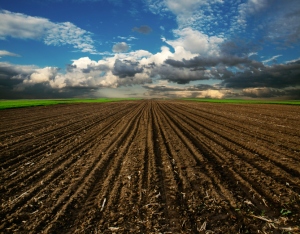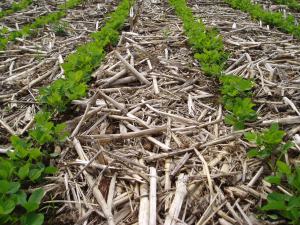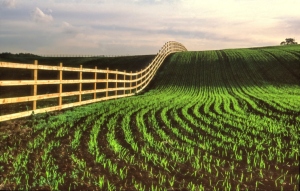It is spring and that means it is time for farmers to get out into the fields and start planting. Farmers have to dodge rainstorms and when skies are clear they might work through the night to get seeds into the ground. Iowa has amazingly rich and robust soil for those seeds to germinate in. That rich, black topsoil does need some preparation for the ideal growth of seeds. But, have you ever wondered why farmers plow their fields before they plant?
 Seeds are typically only planted an inch below the soil surface. Farmers want to give those seeds the best chance of germinating and growing. That means mechanically preparing seed beds by breaking the ground. Soil can become dense and compact. Plowing also makes it easier to plant. Plowing breaks up the blocky structure of the soil which can aid in drainage and root growth.
Seeds are typically only planted an inch below the soil surface. Farmers want to give those seeds the best chance of germinating and growing. That means mechanically preparing seed beds by breaking the ground. Soil can become dense and compact. Plowing also makes it easier to plant. Plowing breaks up the blocky structure of the soil which can aid in drainage and root growth.
Plowing fields can also turn organic matter into soil to increase decomposition and add nutrients from the organic matter to the soil. Many farmers spread manure from cattle and swine onto their fields. This manure is rich in nitrogen which is essential for plant growth. Turning the soil over not only mixes this organic matter, but it also increases oxygen in the soil which speeds up decomposition of the organic matter and makes more oxygen available for the plant roots.
 One problem that farmers face is weeds in their field. Weeds compete with the planted crop for water and essential nutrients. Weeds typically grow fast and can crowd out the desired crop. One advantage of plowing is that it can mechanically break up weed roots and disrupt weeds from growing. By mechanically controlling weeds farmers may be able to spray fewer herbicides to control the weeds. Harvested crops are also graded by the amount of ‘foreign’ material in them. A bushel of wheat will be worth more if it has fewer weed seeds in it. So, having fewer weeds can lead to increased profit.
One problem that farmers face is weeds in their field. Weeds compete with the planted crop for water and essential nutrients. Weeds typically grow fast and can crowd out the desired crop. One advantage of plowing is that it can mechanically break up weed roots and disrupt weeds from growing. By mechanically controlling weeds farmers may be able to spray fewer herbicides to control the weeds. Harvested crops are also graded by the amount of ‘foreign’ material in them. A bushel of wheat will be worth more if it has fewer weed seeds in it. So, having fewer weeds can lead to increased profit.
Planting seeds is always weather dependent. Farmers need to wait until the soil temperature is above 50 degrees Fahrenheit so that the seeds will germinate. Farmers want to plant as early as possible so that they can maximize a short growing season and give their crops the best chance to be productive. Black soil will absorb more sunlight and increase that soil temperature more quickly than soil that has plant matter on it. Plant matter reflects some sunlight and might delay how quickly soil temperature warms to 50 degrees Fahrenheit.
Farming is about Decisions
 There are a lot of reasons for farmers to plow or till their fields. But, plowing does present some challenges and costs. One of the principle problems with plowing fields is the potential wind and water erosion that might carry soil away from the field. For this reason many farmers chose to plant their fields using no-till technology in which last year’s organic matter is left on the surface and seeds are drilled directly into soil without plowing. The organic matter from previous years helps hold the soil in place.
There are a lot of reasons for farmers to plow or till their fields. But, plowing does present some challenges and costs. One of the principle problems with plowing fields is the potential wind and water erosion that might carry soil away from the field. For this reason many farmers chose to plant their fields using no-till technology in which last year’s organic matter is left on the surface and seeds are drilled directly into soil without plowing. The organic matter from previous years helps hold the soil in place.
While plowing or tilling fields can disrupt the weed lifecycle, it can also disrupt the microorganisms in the soil and adversely affect the soil health. Bacteria, fungi, worms and insects that all live in the soil create a unique environment that contribute to the health of the soil. It is many of these organisms that breakdown the organic matter in and on the soil.
 Ultimately farmers need to decide if the benefits of plowing their fields outweigh the risks of soil erosion. They can choose between conventional tillage, reduced tillage, and conservation tillage. They need to decide if tilling harms the microorganisms that live in the soil. Many Iowa farmers have chosen to practice no-till farming because it does have many positive benefits to the environment. Most farmers don’t actually ‘plow’ their fields. They either use conservation tillage methods or do not till the soil at all. Traditional plowing by definition turns up bare soil and buries all plant residue leaving soil vulnerable to wind and water erosion. Plowing also creates clods and an uneven seedbed for planting. This traditional, old fashioned form of plowing hasn’t been practiced commonly in Iowa for 25-30 years. Farmers try minimally disruptive techniques that leave much of the plant residue on the surface of the soil helping reduce erosion. But, every field is different and farmers need to decide what works best for them and their operation.
Ultimately farmers need to decide if the benefits of plowing their fields outweigh the risks of soil erosion. They can choose between conventional tillage, reduced tillage, and conservation tillage. They need to decide if tilling harms the microorganisms that live in the soil. Many Iowa farmers have chosen to practice no-till farming because it does have many positive benefits to the environment. Most farmers don’t actually ‘plow’ their fields. They either use conservation tillage methods or do not till the soil at all. Traditional plowing by definition turns up bare soil and buries all plant residue leaving soil vulnerable to wind and water erosion. Plowing also creates clods and an uneven seedbed for planting. This traditional, old fashioned form of plowing hasn’t been practiced commonly in Iowa for 25-30 years. Farmers try minimally disruptive techniques that leave much of the plant residue on the surface of the soil helping reduce erosion. But, every field is different and farmers need to decide what works best for them and their operation.
-Will
Pingback: Year of Soil! | Iowa Agriculture Literacy
Hello. This message is for Will. My name is Ryan, and I was wondering if you could contact me? I would like to use one of your photos that you have attached in this blog. The one of tilled soil with the beautiful sky. Could you please email me at (rkeehn@live.com)
Thank you
LikeLike
One thing you didn’t mention: tilling or ploughing is weed control. Without tilling they need other methods to control the weed. This is mainly Glyphosate. At the moment no one knows how harmful it will be some day.
LikeLike
Pingback: Tilling Vs. Plowing: Understanding The Difference | TopTillers.com
I went back to moldboard plowing!
It’s by far better but one must know when to plow and follow up disking! I’m 62 and seen a lot of both sides! My father, grandfathers, great grandfathers farmed! Crop rotation is essential, depending on weather some conservation tilling works in well! But rotation is key to weed control! Thanks! Rick
LikeLike
Pingback: Exploring the Latest Advancements in Agricultural Equipment - Ohio Valley Manufacturing
Pingback: Agricultural literacy: why today? – Lines Are Busy
Pingback: Controversial ideas – to plough or not to plough – In The Field
Pingback: What Do They Mean? Corn Vocabulary | Iowa Agriculture Literacy
Pingback: Soil and Water Conservation Practices – What are They Doing? | Iowa Agriculture Literacy
Pingback: Tiller vs Cultivator for Your Garden: Top Options 2019: Own The Yard
Pingback: Adding Inputs (soil) – EEC Forest Stewardship
Pingback: Alleviating the Problems of Plowing, Solution 1: No-Till Agriculture – Scripture, Creation, and Life
Pingback: Unique Farming Challenges – Armadillos? | Iowa Agriculture Literacy
Pingback: Machines needed for a successful farming business - Ridzeal
Pingback: Advancements in Agricultural Equipment - Ohio Manufacturing
Pingback: Continuum Ag: Helping Farmers Sequester Carbon in Soil-Home Automation Brother's Technology
Pingback: Top 14 mở xới là gì mới nhất năm 2022 - tophoidap
Pingback: What Do Farmers Do In The Spring – Agriculture Questions
Pingback: Las mejores prácticas para el uso de residuos vegetales - herramientas agricola
Pingback: Gestión de labranza cero - Siembra sin arado - herramientas agricola
Pingback: Tillers Vs Cultivators: The 5 Best Choices